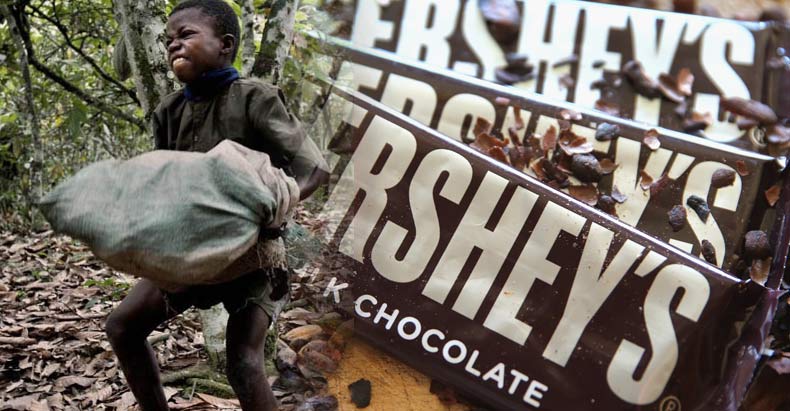A class action lawsuit filed late last month against Nestle, Hershey, and Mars, by three California residents, alleges that the companies are guilty of false advertising for deceiving customers into unwittingly supporting child slave labor, by failing to disclose the use of child slavery in the creation of their chocolate products.
“America’s largest and most profitable food conglomerates should not tolerate child labor, much less child slave labor, anywhere in their supply chains,” the complaint in the class action lawsuit alleges.
These companies should not turn a blind eye to known human rights abuses… especially when the companies consistently and affirmatively represent that they act in a socially and ethically responsible manner.
This is not the first time there have been substantiated allegations of child slavery in the chocolate industry as the problem first drew national attention in 2000, with a documentary titled Slavery: A Global Investigation.
The organization behind the film, True Vision Entertainment exposed the strategies used by the chocolate industry to amass staggering wealth. The report documented alleged connections between child slaves in the Ivory Coast of Africa and the chocolate industry.
West Africa is home to two-thirds of the world’s cacao beans (cocoa), the main ingredient in chocolate—a product that fuels a $90 billion dollars a year industry.
The documentary provided an insightful look into the brutal reality of child slaves, as the film opens with emaciated looking boys hauling hundred-pound sacks of cocoa pods on their backs.
According to a report in The Daily Beast:
The boys’ stories are sickeningly graphic. Before beatings, the boys say they were stripped naked and tied up. They were then pummeled with a variety of weapons, from fists and feet to belts and whips. In the film, some of the boys get up and imitate the beatings. Others stand to reveal hundreds of scars lining their backs and torsos—some still bloody and scabbed. They get quiet when the filmmakers ask whether any are beaten today and say some are simply “taken away.”
 In the award-winning film, former slaves tell of routine brutality and describe being worked from dawn until dusk daily, then locked up in a shed at night and given only a tin cup in which to urinate.
In the award-winning film, former slaves tell of routine brutality and describe being worked from dawn until dusk daily, then locked up in a shed at night and given only a tin cup in which to urinate.
“The beatings were a part of my life,” says Aly Diabata, one of the former child laborers. “I had seen others who tried to escape. When they tried, they were severely beaten.”
When one of the boys was asked what he would say to the billions of people who eat chocolate across the globe, he replied:
They enjoy something I suffered to make; I worked hard for them but saw no benefit. They are eating my flesh.
After the film’s release, there was widespread public outrage. This public discontent quickly resulted in congressional legislation being drafted, which would have asked the Food and Drug Administration to introduce a “slave-free” label.
The bill was quickly approved in the House of Representatives, and was expected to pass in the Senate, but before a vote could be taken, the chocolate industry made a sweet deal; promising that they would begin to self-regulate their behavior, and ultimately eliminate the use of child slave labor by 2005. An agreement, billed as the Engel-Harkin Protocol (aka the Cocoa Protocol), was signed in September of 2001.
According to The Daily Beast:
Eight companies—including Nestle, Mars, and Hershey—were signatories of the massive accord, pledging $2 million to investigate the labor practices and eliminate the “Worst Forms of Child Labor,” the official term from the International Labor Organization, by 2005. When the July 2005 deadline arrived with the industries yet to make major changes, an extension was granted until 2008.
When the next deadline came and went, a new proposal arose. By 2010, the companies basically started anew with a treaty called The Declaration of Joint Action to Support Implementation of the Harkin-Engel Protocol. This document pledges to reduce the worst forms of child labor by 70 percent across the cocoa sectors of Ghana and Ivory Coast by 2020.
The industry seemingly has a trend of kicking the can of accountability down the road, while continuing to rake in massive profits on the back of child slave labor.
Since the signing of the Cocoa Protocol, the number of child slave laborers in the cocoa industry has actually increased dramatically. A report from the Payson Center for International Development of Tulane University, and sponsored by the U.S. Department of Labor, found the number of children working in the cocoa industry in 2013-14 increased 51 percent to 1.4 million, compared to the last report in 2008-09.
The class action suits seek both revised packaging that denotes child slaves were used and monetary damages for California residents who have purchased the chocolate. This lawsuit is simply the latest step in attempting to increase pressure on an industry that continues to profit from the most vile of acts; the enslaving of another human being.
 “Children that are sometimes not even 10 years old carry huge sacks that are so big that they cause them serious physical harm,” the complaint alleges. “Much of the world’s chocolate is quite literally brought to us by the back-breaking labor of child slaves.”
“Children that are sometimes not even 10 years old carry huge sacks that are so big that they cause them serious physical harm,” the complaint alleges. “Much of the world’s chocolate is quite literally brought to us by the back-breaking labor of child slaves.”
The complaint goes on to claim that many of the children are sold into slavery for less than $30, some are kidnapped, while others are tricked into thinking it is a legitimate job, only to be threatened, caged and beaten. These children are forced to work between 80-100 hours per week in grueling conditions with no pay. Often, the children are beaten or killed if they attempt to escape.
While the companies all contend the suit is without merit, others who have researched the subject find validity in the lawsuit’s allegations. Award-winning documentary filmmaker, Miki Mistrati, who released a movie on the subject in 2014, Shady Chocolate, took direct aim at the industry.
“Mars, Hershey, and Nestle have had every opportunity to stop the trafficking of children and illegal child slaves,” Mistrati told The Daily Beast.
I have seen small children, 6 years old, being trafficked from Mali to Ivory Coast. It was so heartbreaking to watch. But the companies have not had the will to end it for many years. Only empty words and expensive advertising instead of using money to pay back to the children on the ground in West Africa.
These mega corporations have denied all charges made against them, and claim to “abhor” child slave labor, yet they continue to reap the rewards of not enacting firm policies and procedures as to disallow the use of any child slave labor from the production chain.
Natural and Non-Toxic Products. Up to 50% Off – Every Day (Ad)
These companies have essentially duped the American public into indirectly supporting child slave labor through their failure to disclose the widespread use of the practice in the chocolate industry.
The continuing exploitation of these innocent children, 15 years after first being exposed to the light of public scrutiny, exposes how little human lives are valued compared to profits by those in control of these corporations and the U.S. government.
Please share this story to help pressure the chocolate industry to ban the practice of using child slave labor in chocolate production!


How many of these ‘chocolate slave traders’ contributed to the Clinton Global Initiative?
Be very careful about this lawsuit. Firstly it has been brought about by Hagens Berman Sobol Shapiro,Lawyers.Talmudic shyster ambulance chasers and dual nationals.
Now what they call child labor may just be the only way these families can survive and eat but if the lawyers can extract some wealth and publicity from this, well, screw the family
CGB, they actually kidnap the kids from their family and force them into slave labor for years. They may even kill the kids after they use them up. It’s the American way.